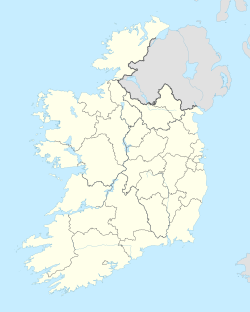Top Qs
Timeline
Chat
Perspective
Ardfinnan
Village in County Tipperary, Ireland From Wikipedia, the free encyclopedia
Remove ads
Ardfinnan (Irish: Ard Fhíonáin, meaning 'Hill of Finnian') is a small village in County Tipperary in Ireland. It is situated on the River Suir and R665 regional road. The Catholic parish of Ardfinnan is made up of three areas: Ardfinnan, Ballybacon, and Grange. Ardfinnan is also a civil parish in the ancient barony of Iffa and Offa West.[2] The village is located 14 km (9 mi) from the town of Clonmel and 10 km (6 mi) from Cahir via the R670 road. The population of the village is approximately 900 people.[1]
Remove ads
Transport
During the week it is served five times a day in each direction by Bus Éireann route 245 linking it to Clonmel, Mitchelstown, Fermoy and Cork. At the weekend there are three buses each way.
Saint Carthage of Lismore
In the early 7th century Saint Carthage travelled through "Ard Breanuinn on the bank of the river Suir", where he took rest and was confronted by King Maolochtair and his noblemen. Carthage made peace with them and was granted this land with a similar place at Lismore for monastic settlement, from which grew the settlements of Ardfinnan, and that of Lismore around his great Lismore Abbey[3].
Saint Declan journeyed through here on his famous pilgrimage walks from Ardmore to Cashel, “Saint Declan’s Way”, back in the early 5th century to meet Saint Patrick.
Remove ads
Ardfinnan Abbey
It is traditionally believed that Saint Fíonán Lobhar (or Finnian the Leper) founded an abbey with a leper colony here in the 6th century, high up on the site of the now present castle, known as Ard Brennuin and later Ard Finnan in his namesake, where the village gets its name. The 10th century text Litany of Irish Saints II refers to it as “de muntir Fhinnio i nAird Brendomnaig”[4] and closely means “monastery of Finnian on the hill of Brennuin”.
In 908, King of Munster Cormac mac Cuilennáin bequeathed one ounce of gold, one ounce of silver, his horses, armour and sword to the abbey. The abbey was said to be fleed, then plundered and burnt by Cambro-Normans during the Norman Invasion of Ireland in 1178.[citation needed] It possibly reformed 4 miles north at Caher Abbey in Cahir.
A Carmelite abbey was later built on the opposite side of the river valley, known as Lady's Abbey, of which its ruin is still extant after it was destroyed during the English Reformation. There was also a monastery for Franciscan Friars, Third Order Regular.[citation needed]
Ardfinnan Castle
A prominent feature of the village is the Anglo-Norman Ardfinnan Castle, built with its sister Lismore Castle by Prince John of England in 1185. As Lord of Ireland, John issued royal charters from the castle during his brief stay there.[5] The castle and surrounding manor was the site of numerous battles defending the border of Waterford. The 14 arch bridge was started soon after the castle was completed. The castle has a long and varied history of owners, including the Knights Templar, and is inhabited to the present. The castle is a private residence and is not open to the public.[6]
Remove ads
Economy
Summarize
Perspective
Mills

Ardfinnan Woollen Mills which made its renowned Ardfinnan tweeds and worsteds was established by the Mulcahy family in 1869, taking over a former flour mill leased by James Fennell, a Quaker, from James Prendergast of Ardfinnan Castle. The castle’s mill was there since before the Civil Survey of 1654, when flour milling would have sustained knights in the castle. The older monastic settlements would have brought milling and learned crafts to the area. Historical traditions of spinning and weaving in the village suggests the Knights Templar finished locally woven cloth by fulling at the mill in the Middle Ages. A William le Teynturer (William the Dyer, of cloth) is recorded in the village in 1295.[7]
The woollen mills became a leading firm in Irish textiles and was of great benefit to the village of Ardfinnan, providing employment to over 220 workers at its peak and electricity for streetlights and homes in the surrounding area long before the Rural Electrification Scheme was introduced. HM King Edward VII visited the mills in the 1900s. It closed in 1973.
Developments
Ardfinnan was a location, used by Atari, for the manufacture of wooden video game arcade cabinets from 1974 to 1984. At its height 200 workers were building 2,000 arcade cabinets a month at the location just outside the village. The plant in Ardfinnan closed in 1989.[8]
Insulation manufacturer, Moy Isover were also based in the village since 1974 before finally closing in 2008.[9]
In January 2017, €800,000 was allocated for essential remedial works on the bridge by the government. As a public safety initiative, a traffic light one way system has been in place on the bridge since the end of 2015 after significant structural damage was discovered.[10]
Remove ads
Sport
Ballybacon-Grange GAA is the local Gaelic Athletic Association hurling club.
Ardfinnan GAA is the local Gaelic Athletic Association Gaelic football club. They were Tipperary county Gaelic football champions in 2005.
Ardfinnan Anglers have licensed fishing rights to approximately 15 km of river bank on the river Suir. Brown trout and Salmon can be caught in these waters. The river banks are maintained annually by club members who perform the work voluntarily before the commencement of the annual fishing season.[citation needed]
Remove ads
See also
References
External links
Wikiwand - on
Seamless Wikipedia browsing. On steroids.
Remove ads


